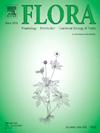Extrafloral nectary plants in Brazilian biomes: Dominance of Cerrado and Fabaceae
IF 1.7
4区 生物学
Q3 ECOLOGY
引用次数: 0
Abstract
Extrafloral nectaries (EFNs) have been described in almost 4500 plant species, but there are several gaps in our knowledge of their occurrence and distribution. Here, we investigated the distribution and richness of EFN˗plants in Brazilian biomes. Data were extracted from published literature, and our analysis included only EFN˗plants that interacted with ants. A total of 234 EFN˗plant species in 47 families were registered in the Cerrado, Atlantic Forest, Caatinga, Pampa, and the Amazon. The Cerrado was evaluated in 65 % of all publications and had the highest richness (92 species) and the most exclusive species compared to the other biomes. Fabaceae was the most speciose family and was dominant in all biomes (except in the Amazon). Only 13 of 234 plant species were observed in more than one biome. In a network analysis, Qualea grandilflora, Turnera subulata and Plathymenia reticulata were relatively more important than other species, as they connected biomes and increased the community's cohesion. Our understanding of EFN˗plants is limited because the Fabaceae and Cerrado were overrepresented. In addition, the high exclusivity of flora within biomes adds a regional factor to our understanding of ant–plant interactions. Our data of plants visited by ants were compared with descriptive checklists of EFN˗plants, and 127 species and 16 families of EFN˗plants unknown from checklists were identified. Conversely, checklists contain hundreds of EFN˗plants from which interactions with ants are unknown, indicating a great potential for studies of ant–plant interactions and mutualisms.
求助全文
约1分钟内获得全文
求助全文
来源期刊

Flora
生物-植物科学
CiteScore
3.30
自引率
10.50%
发文量
130
审稿时长
54 days
期刊介绍:
FLORA publishes original contributions and review articles on plant structure (morphology and anatomy), plant distribution (incl. phylogeography) and plant functional ecology (ecophysiology, population ecology and population genetics, organismic interactions, community ecology, ecosystem ecology). Manuscripts (both original and review articles) on a single topic can be compiled in Special Issues, for which suggestions are welcome.
FLORA, the scientific botanical journal with the longest uninterrupted publication sequence (since 1818), considers manuscripts in the above areas which appeal a broad scientific and international readership. Manuscripts focused on floristics and vegetation science will only be considered if they exceed the pure descriptive approach and have relevance for interpreting plant morphology, distribution or ecology. Manuscripts whose content is restricted to purely systematic and nomenclature matters, to geobotanical aspects of only local interest, to pure applications in agri-, horti- or silviculture and pharmacology, and experimental studies dealing exclusively with investigations at the cellular and subcellular level will not be accepted. Manuscripts dealing with comparative and evolutionary aspects of morphology, anatomy and development are welcome.
 求助内容:
求助内容: 应助结果提醒方式:
应助结果提醒方式:


